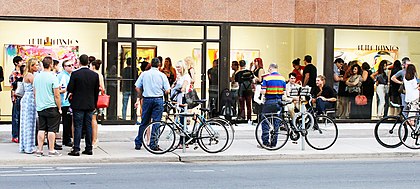
Contemporary art is the art of today, produced in the second half of the 20th century or in the 21st century. Contemporary artists work in a globally influenced, culturally diverse, and technologically advancing world. Their art is a dynamic combination of materials, methods, concepts, and subjects that continue the challenging of boundaries that was already well underway in the 20th century. Diverse and eclectic, contemporary art as a whole is distinguished by the very lack of a uniform, organising principle, ideology, or "-ism". Contemporary art is part of a cultural dialogue that concerns larger contextual frameworks such as personal and cultural identity, family, community, and nationality.

An art museum or art gallery is a building or space for the display of art, usually from the museum's own collection. It might be in public or private ownership, be accessible to all, or have restrictions in place. Although primarily concerned with visual art, art museums are often used as a venue for other cultural exchanges and artistic activities, such as lectures, jewelry, performance arts, music concerts, or poetry readings. Art museums also frequently host themed temporary exhibitions, which often include items on loan from other collections.

The Isabella Stewart Gardner Museum is an art museum in Boston, Massachusetts, which houses significant examples of European, Asian, and American art. Its collection includes paintings, sculpture, tapestries, and decorative arts. It was founded by Isabella Stewart Gardner, whose will called for her art collection to be permanently exhibited "for the education and enjoyment of the public forever."

The art world comprises everyone involved in producing, commissioning, presenting, preserving, promoting, chronicling, criticizing, buying and selling fine art. It is recognized that there are many art worlds, defined either by location or alternative definitions of fine art. Some may use the singular art world to refer only to the elite level of globalized fine art. The art world(s) are continually changing in response both to the creativity of those that create art and in response to social change.
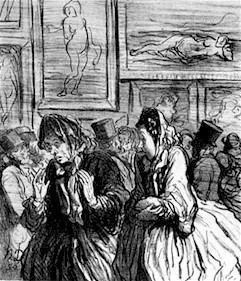
An art exhibition is traditionally the space in which art objects meet an audience. The exhibit is universally understood to be for some temporary period unless, as is occasionally true, it is stated to be a "permanent exhibition". In American English, they may be called "exhibit", "exposition" or "show". In UK English, they are always called "exhibitions" or "shows", and an individual item in the show is an "exhibit".

Louise Lawler is a U.S. artist and photographer living in Brooklyn, New York. From the late 1970s onwards, Lawler’s work has focused on photographing portraits of other artists’ work, giving special attention to the spaces in which they are placed and methods used to make them. Examples of Lawler's photographs include images of paintings hanging on the walls of a museum, paintings on the walls of an art collector's opulent home, artwork in the process of being installed in a gallery, and sculptures in a gallery being viewed by spectators.

Leo Castelli was an Italian-American art dealer who originated the contemporary art gallery system. His gallery showcased contemporary art for five decades. Among the movements which Castelli showed were Surrealism, Abstract Expressionism, Neo-Dada, Pop Art, Op Art, Color field painting, Hard-edge painting, Lyrical Abstraction, Minimal Art, Conceptual Art, and Neo-expressionism.

The Los Angeles Art Association (LAAA), non-profit arts organization that's been around for 96 years, helps up-and-coming artists. It was created in 1925 to let folks in Los Angeles see high-quality art and build a collection of European and American art for the people of the city.

An art dealer is a person or company that buys and sells works of art, or acts as the intermediary between the buyers and sellers of art.

ACE Gallery is an internationally recognized art gallery specializing in contemporary art. ACE Gallery Los Angeles is located in the Miracle Mile section of Los Angeles a few blocks east of Museum Row.
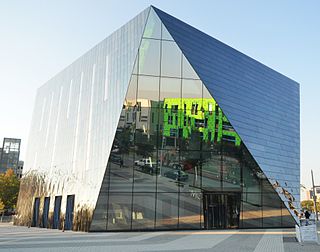
The Museum of Contemporary Art Cleveland is a contemporary art museum in Cleveland, Ohio, United States. It is the only contemporary art venue of its kind in Metropolitan Cleveland. The organisation was founded by Marjorie Talalay, Agnes Gund, and Nina Castelli Sundell in 1968 and has undergone several name and venue changes in the years following its 1968 founding. Originally known as The New Gallery, the museum was rebranded as the Cleveland Centre for Contemporary Art in 1984. The gallery has operated under its current branding as the Museum of Contemporary Art Cleveland (moCa) since 2002.
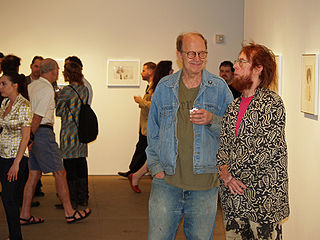
A contemporary art gallery is normally a commercial art gallery operated by an art dealer which specializes in displaying for sale contemporary art, usually new works of art by living artists. This approach has been called the "Castelli Method" after Leo Castelli, whose success was attributed to his active involvement in discovering and promoting emerging artists beginning in the late 1950s with Jasper Johns and Robert Rauschenberg.
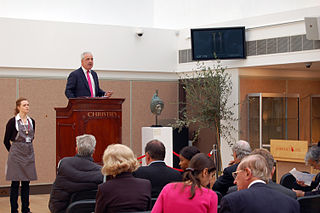
Art valuation, an art-specific subset of financial valuation, is the process of estimating the market value of works of art. As such, it is more of a financial rather than an aesthetic concern, however, subjective views of cultural value play a part as well. Art valuation involves comparing data from multiple sources such as art auction houses, private and corporate collectors, curators, art dealer activities, gallerists, experienced consultants, and specialized market analysts to arrive at a value. Art valuation is accomplished not only for collection, investment, divestment, and financing purposes, but as part of estate valuations, for charitable contributions, for tax planning, insurance, and loan collateral purposes. This article deals with the valuation of works of fine art, especially contemporary art, at the top end of the international market, but similar principles apply to the valuation of less expensive art and antiques.

The Archives of American Art is the largest collection of primary resources documenting the history of the visual arts in the United States. More than 20 million items of original material are housed in the Archives' research centers in Washington, D.C., and New York City.

An exhibition, in the most general sense, is an organized presentation and display of a selection of items. In practice, exhibitions usually occur within a cultural or educational setting such as a museum, art gallery, park, library, exhibition hall, or World's fairs. Exhibitions can include many things such as art in both major museums and smaller galleries, interpretive exhibitions, natural history museums and history museums, and also varieties such as more commercially focused exhibitions and trade fairs. They can also foster community engagement, dialogue, and education, providing visitors with opportunities to explore diverse perspectives, historical contexts, and contemporary issues. Additionally, exhibitions frequently contribute to the promotion of artists, innovators, and industries, acting as a conduit for the exchange of ideas and the celebration of human creativity and achievement.

Merton Daniel Simpson was an American abstract expressionist painter and African and tribal art collector and dealer.
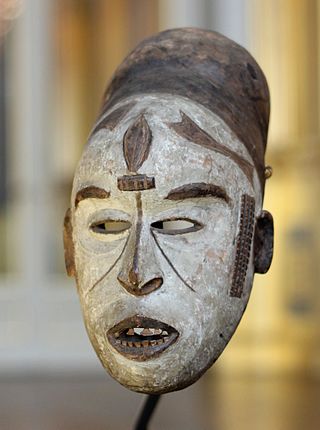
Some African objects had been collected by Europeans for centuries, and there had been industries producing some types, especially carvings in ivory, for European markets in some coastal regions. Between 1890 and 1918 the volume of objects greatly increased as Western colonial expansion in Africa led to the removal of many pieces of sub-Saharan African art that were subsequently brought to Europe and displayed. These objects entered the collections of natural history museums, art museums and private collections in Europe and the United States. About 90% of Africa's cultural heritage is believed to be located in Europe, according to French art historians.

Cameron Rowland is an American conceptual artist whose work has been exhibited internationally and acclaimed for its structural analytic approach to addressing issues of American slavery, mass incarceration, and reparations. Rowland graduated from Wesleyan University in 2011 and they were awarded the MacArthur Fellowship in 2019 after several solo and group exhibitions at venues including the Museum of Modern Art, Whitney Museum of American Art, Kunsthal Aarhus, and La Biennale de Montreal. Rowland is noted for their distinct method of loaning some works to collectors and institutions rather than selling them outright, an approach meant to mirror the experience of low-income people shopping at rent-to-own stores like Rent-A-Center and disrupt the traditional value structure in the contemporary art market.

The Iloilo Museum of Contemporary Art (ILOMOCA) is an art museum in Iloilo City, Philippines. It is the first museum in the Visayas and Mindanao dedicated to modern art.
Miguel Jorge (1928–1984), also known as “Micky” Jorge, was a Cuban artist who was influential in the establishment of South Florida's early Latin American art market in the Greater Miami area from the 1960s through the 1980s.


